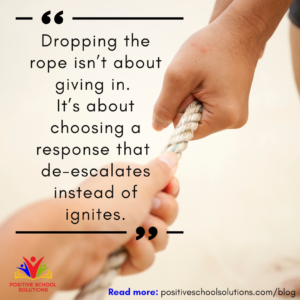Drop the Rope: Avoiding Power Struggles in the Classroom
It’s that time of year. The honeymoon period is long gone, students are testing limits, and teachers are feeling the weight of daily classroom management. Again and again, I hear from educators who say:
“I give a direction, and a student immediately pushes back—’I’m not doing that!’
—and before I know it, we’re in a full-blown power struggle.“
This scenario is all too common. And in my mind, it’s like this:
The student is throwing the teacher a rope and saying, “Let’s play tug-of-war!”
And the teacher, feeling the need to maintain control, picks up the rope and starts pulling with all their might.
Here’s the problem: Once you’re in the game, you can’t win.
Pretty soon, the teacher is either locked in a never-ending tug-of-war with one student, OR they’re playing multiple games of tug-of-war at once—exhausted, frustrated, and wondering why they feel like they’re fighting all day.
But there’s a better way: DROP THE ROPE.
It’s impossible to play tug-of-war if no one is pulling back.
When we stop engaging in power struggles, we take away the fuel that keeps the game of tug-of-war going. The moment a student realizes they can’t pull you into the fight, the game loses its appeal.
So, how do we do this in real time? Let’s break it down.
Instead of This… Try This
Here are some common power struggle scenarios and different ways to respond:
Scenario 1: The Direct Defiance
Student: “I’m not doing that.”

(Rope is picked up. The struggle begins.)

(Drops the rope, removes the confrontation, and puts the responsibility on the student.)
Why it works: It acknowledges the student’s autonomy while keeping expectations clear. No argument, no power struggle.
Scenario 2: The Backtalk Battle
Student: “This is stupid. I’m not doing it.”

(Rope picked up. The power struggle intensifies.)

Why it works: Redirects the conversation and removes the emotional charge.
Scenario 3: The Procrastination Game
Student: “I’ll do it later.”

(Rope picked up. The student digs in.)

Why it works: Provides structure without engaging in a power struggle, making it more likely the student will comply.
Scenario 4: The Deflection Tactic
Student: “Why do we even have to do this? This is dumb.”


Why it works: It doesn’t dismiss the student’s concern but also doesn’t let them derail the lesson.
The Key to Avoiding Power Struggles: Strong Rules & Engaging Lessons
Dropping the rope is powerful, but if you really want to level up your classroom, make sure you have clear, effective rules and engaging academic lessons in place. When expectations are strong and instruction captivates students, power struggles naturally decrease.
-
- Struggling with classroom rules? Learn how to create rules that actually work in our on-demand course: Successful Implementation of Classroom Rules..
-
- Want to increase engagement? Discover strategies to keep students focused and invested in our Strategies for Increasing Academic Engagement course.
The Power of Dropping the Rope
Every time we refuse to engage in a power struggle, we:
-
- Preserve our energy—no more fighting all day.
-
- Maintain control—without forcing compliance.
-
- Model emotional regulation—showing students how to handle challenges calmly.
Dropping the rope isn’t about giving in. It’s about choosing a response that de-escalates instead of ignites. It’s about recognizing that real authority isn’t about proving you’re in charge—it’s about guiding students to make better choices without engaging in a battle of wills.
So, next time a student throws you the rope… just let it fall.
Your energy, patience, and sanity will thank you.
Written by Sarah Fillion 2025


